The lord of the chateau who plays music for his wines
A chateau in the Jura? Can there really be such a thing in this rural area with down-to-earth growers? Yes, there is at least one that fulfils all the desirable criteria for being called chateau. Dating back to the 16th century, a history of war, of peace, owners that were decapitated, expropriation, return, reconstruction and, above all, winemaking. If you add to this, wines of a very high level, the story is worth taking note of. Join us on a visit to the Domaine du Château d’Arlay together with the owners Alain de Laguiche and his wife Anne and you will find out why they play music for the wine you hopefully will get in your glass someday.
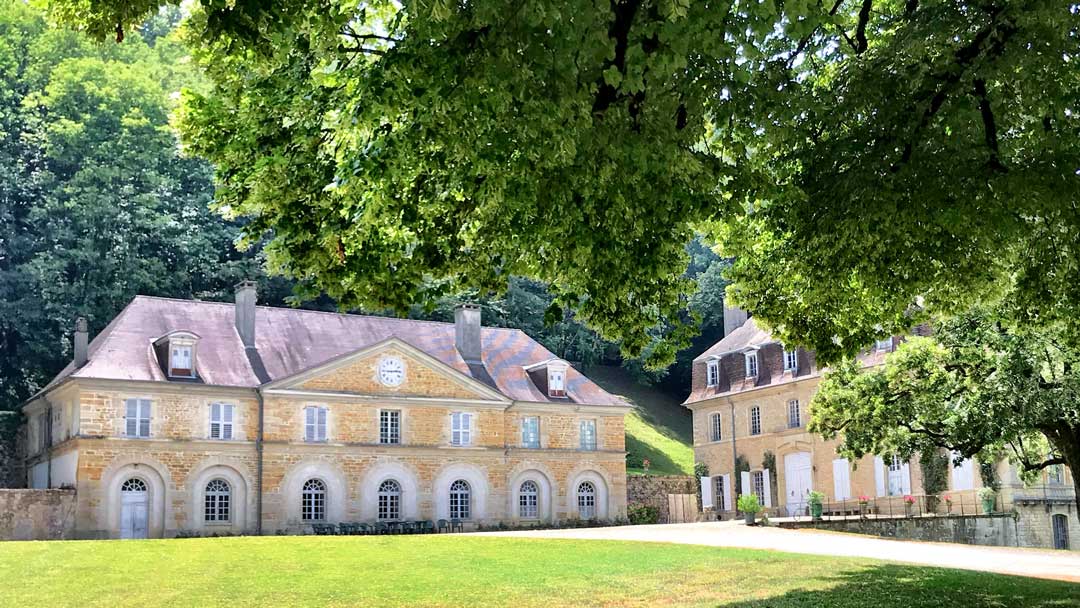
Everything is small scale in the Jura. Appealingly simple, nice, easily navigated with its small size (40 x 80 kilometres), a rich selection of food and very friendly people. If you are also interested in wine, there is a wide range of wines to explore.
Stepping into a chateau may sound a little daunting but the reality turns out to be the exact opposite. Anne de Laguiche guided us through the well-preserved chateau before the tasting. Warm, committed and proud. In excellent English which made it even more memorable for us with limited talent in language. It was thirty-five degrees C in the shade and on the short walk across the courtyard to the tasting room, the transpiration was given a big boost again. Poor France and its growing grapes that were being strained to the limit of the heatwave.
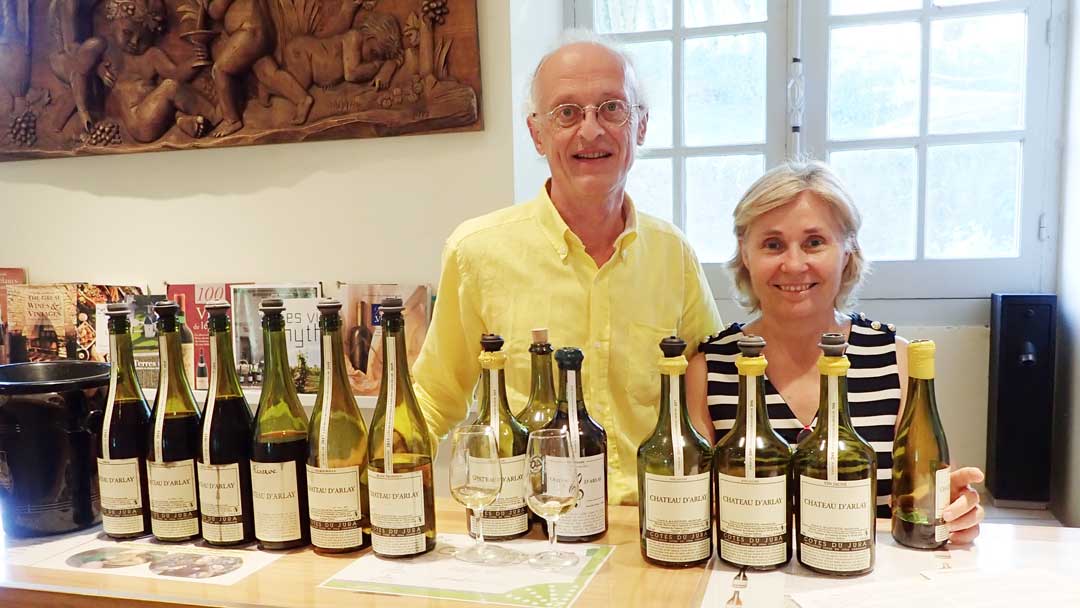
The tasting starts with red, or almost red I should perhaps say. Château d’Arlay Côtes-du-Jura Cuvée Corail 2012 is the only wine in Jura that has a blend of all five permitted grapes. Pinot noir, trousseau, poulsard, chardonnay and savagnin. Three red and two white varieties which are vinified together. It is fresh, easily accessible and tasty.
This was followed by their first pure trousseau, which we hope they continue to produce. Served cool, it is a delicious food wine with its inviting spices and freshness. There is not really an abundance of wines made from the trousseau grape. The plantings are today limited to about eight per cent of the total of 2,100 hectares of Jura. Their Chateau d’Arlay Rouge de Trousseau 2016, Côtes de Jura, was a brilliant example of what the grape can do. This wine is not found on their website, but maybe you can request it from your importer.
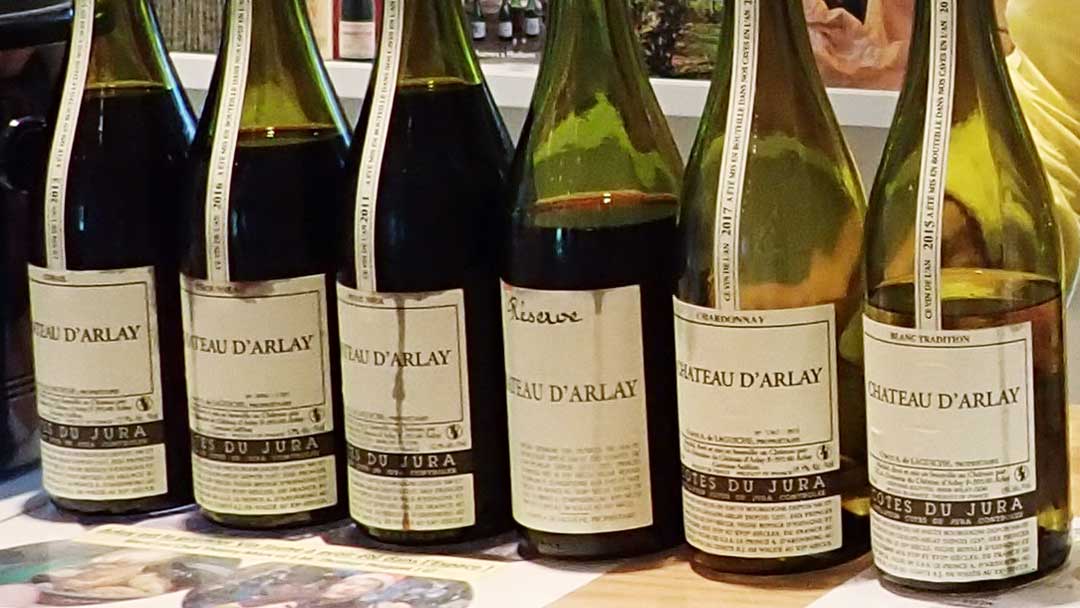
The next glass was filled with Chateau d’Arlay Rouge de Pinot Noir 2011, Côtes de Jura, for a reasonably modest price, which could raise some suspicious thoughts in your head when you put your nose in the glass. Perhaps it is the crazy price evolution in Burgundy that has created the mistaken notion that a good pinot is always expensive. No, it is not the same wine but the experience was delicious and very typical of the grape with high acidity, good grip and a fine range of details. Aged four years in barrels before bottling but in my opinion without a trace of barrels in the character. Served a few degrees below room temperature it was a pure delight.
The white selection was represented, among other things, by the Chateau d’Arlay Blanc de Chardonnay 2017, Côtes de Jura, with finely nuanced oxidized tones which goes against the notes I wrote down indicating ageing in steel tank. [Ed’s comment: This strange effect is something that we also often find in white wines from the Jura, regardless of how they have been made.] Chateau d’Arlay Blanc Tradition 2015, Côtes de Jura, with 2/3 chardonnay and 1/3 Savagnin, on the other hand, was aged in barrels for three years, without being regularly topped up, and bottled in 2019. Definitely with a character of elegant oxidation.
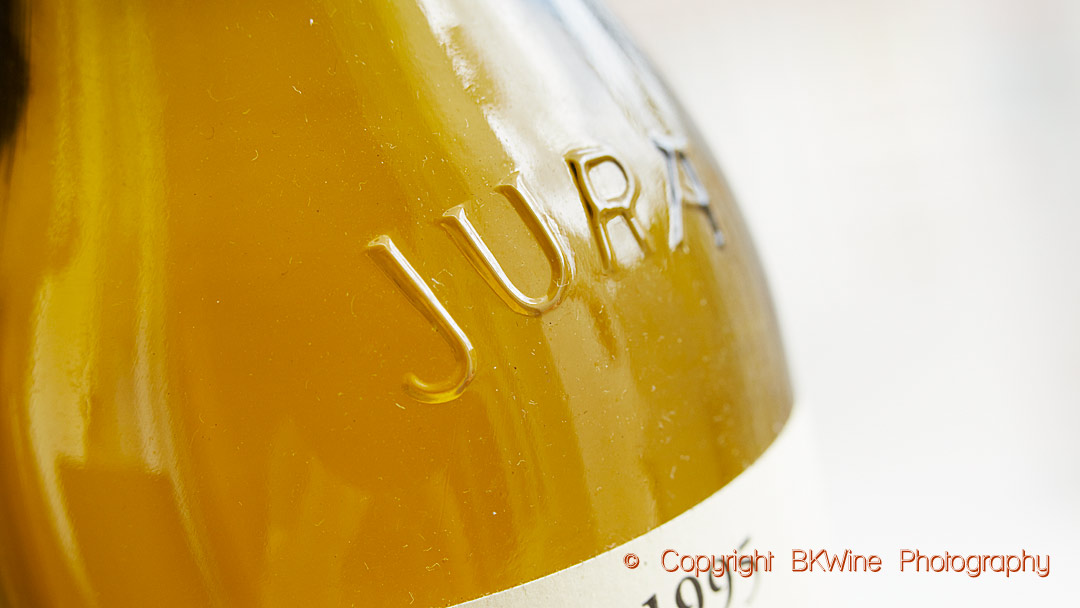
We continued with whites but now over to vin jaune, the yellow wine. One hundred per cent savagnin and to make the technical description short, aged in barrels for seven years, under a layer of yeast that forms under favourable conditions.
Now the tasting is getting really, really interesting. Alain de Laguiche has joined us at the tasting table. Anne sits down, kicks off her shoes, relaxes and explains how nice it is to be served after having rushed around in the record heat prevailing in France.
We try the Chateau d’Arlay vin jaune 2009 and 2010, Côtes de Jura. Both in a dry and fresh style with walnuts, honey, ginger and, I imagined, a hint of rubber in the 2009. The 2010 felt softer and more easily accessible, but these are nuances. Both were clean, dry and insanely fresh.
When we tried the Chateau d’Arlay vin jaune 2011, I felt a noticeable edgy thinner-like hint that tickled my nose. “Aha,” said Alain, “then we’ll make an experiment with you. We’ll see how you enjoy the same wine with some music.”
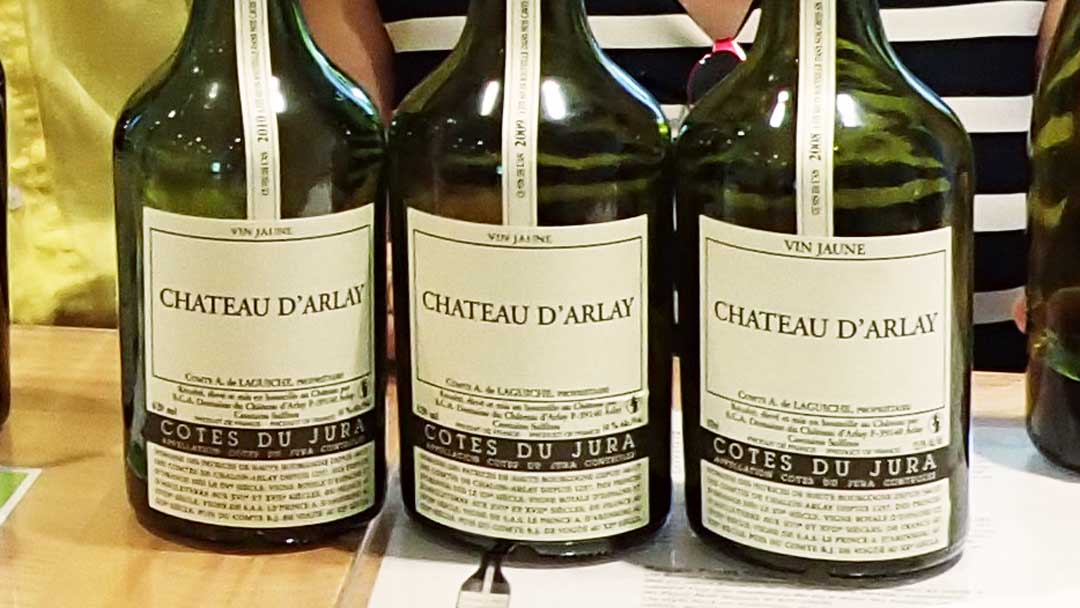
Alain disappeared into the room next door and I wondered what music we would be listening to. But out comes Alain with a bottle with a G clef on the label. It is now one starts wondering if the enthusiasm has turned into madness, but we can simply state that everything that is exposed to pressure waves is affected. In one way or another. The experiment was (hoping that I understood it correctly) that when the wine had been put into barrels, but before the important layer of yeast had appeared, la voile, the barrels were exposed to sound waves. Twice daily for ten minutes, a treatment that was repeated over one month. The intention was that the layer of yeast would form more easily and more evenly to cover the small area of wine that was exposed due to the evaporation from the barrels.
And the answer was yes, there was a difference between the two otherwise identical wines. The wine exposed to the low-frequency sound waves had a rounder character and a softer feeling with higher viscosity. Music simply makes us happier. The wine is sold under the name Chateau d’Arlay vin jaune Cuvée Protéodie 2011. But the question is how many bottles will find their way out on to the market. [Ed’s comment: “prothéodie” is a theory that says that certain types of music can favour the creation of certain types of proteins.]
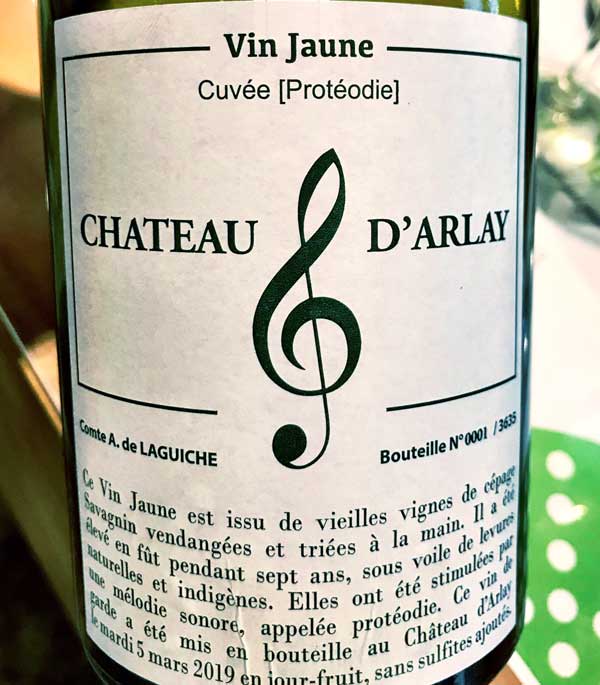
The tasting ended with two variants of macvin, a separate appellation since 1991. It is a fortified “wine” which can contain all five permitted grape varieties. Simply put, it is unfermented grape must to which marc du jura has been added. Marc, at the risk of offending someone with a sense of details, is similar to grappa. Macvin may sound awful to anyone who has not tasted it but is a balanced and delightful experience. As a footnote, I can mention that our host the night before, without asking, served a white macvin as an aperitif with a simple bite to eat as the most natural thing in the world. Refreshing and a boost for the rest of the meal. Many people at home would more often think of macvin as a digestive, preferably with a piece of comté cheese or some semi-sweet dessert. The Chateau d’Arlay Macvin Blanc is 1/3 vieux marc, 1/3 chardonnay must and 1/3 savagnin must. Macvin Rouge is 1/3 Vieux marc and the remaining 2/3 pinot noir. Sugar content about 100 g/l and alcoholic strength 17%.
Visiting Jura, I would categorise the Chateau d’Arlay under the heading “a must” (pun unintended). Primarily because all 17 wines we tasted were of excellent and even quality, but also because of the aura a chateau can offer and the warm and welcoming reception. The Laguiche couple is clearly very involved and present in the winemaking and manages to combine this with a talent to share with visitors. And a tasting with some lovely music comes with it.
Footnote:
You can find a lot of information on www.domaine-arlay.com about the wines and the chateau as well as the opening hours, but not a word about what music the barrels are allowed to “listen to”.
Sven-Olof Johansson is a wine enthusiast in Stockholm with a long history of wine tasting experiences.


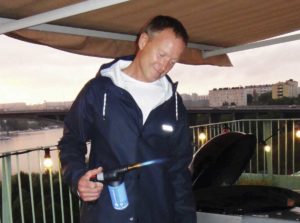
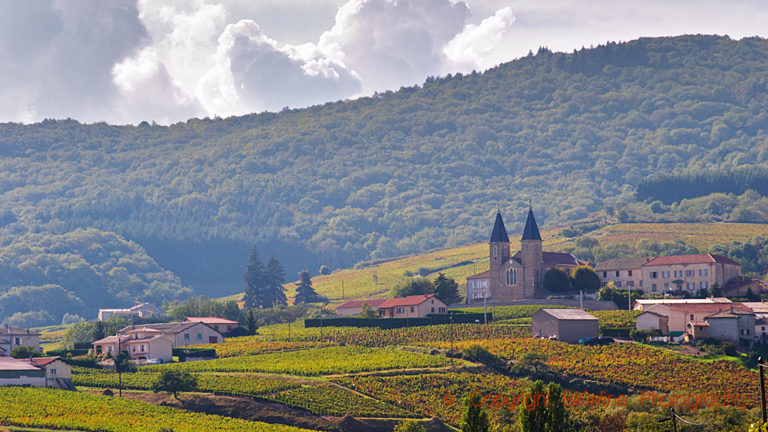
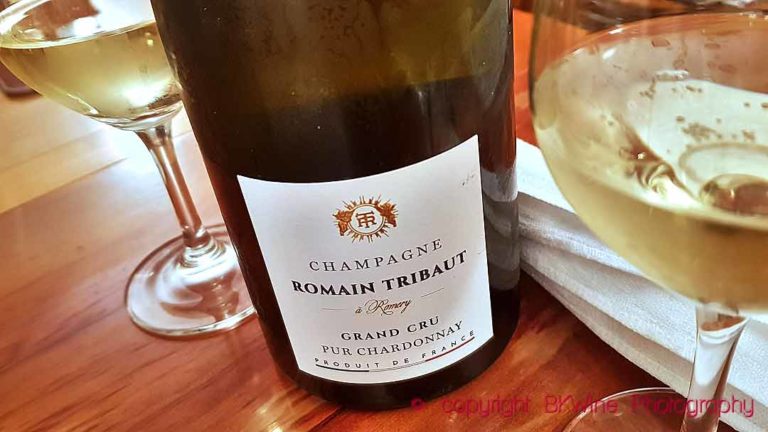
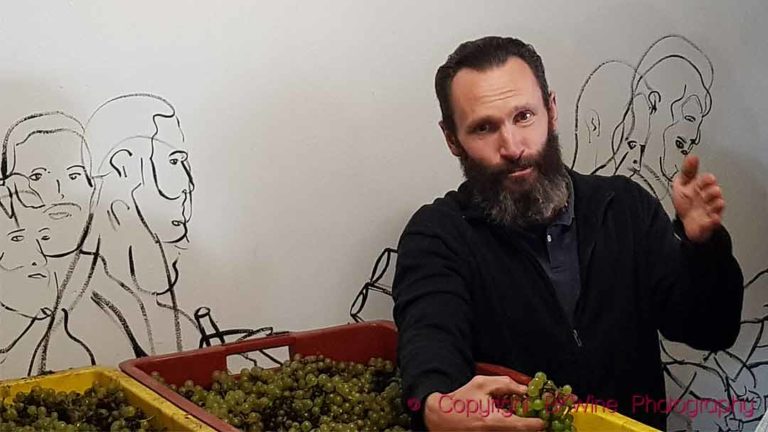






2 Responses
Dear Sir
I am very interested in your wines. I live in Denmark and would like to know where there is a dealer nearby.
Best Regards.
Benny Lassen
Hello Benny, I agree, their wine is really nice. Unfortunately I do not know an importer in Denmark but winetrade.se have them in Sweden.
Good luck finding a bottle. We will try to visit them again this summer. If possible.
Sven-Olof